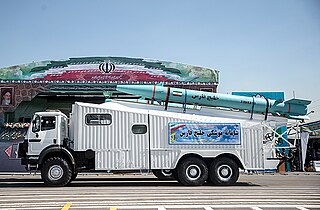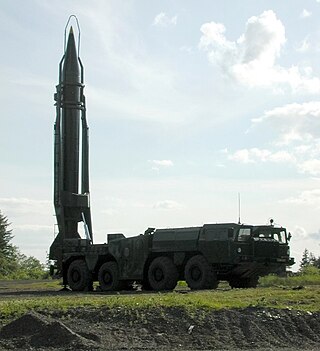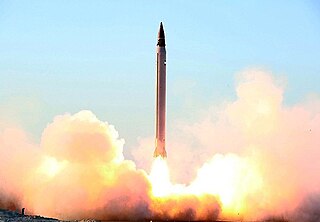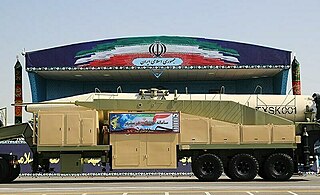
A ballistic missile (BM) is a type of missile that uses projectile motion to deliver warheads on a target. These weapons are powered only during relatively brief periods—most of the flight is unpowered. Short-range ballistic missiles (SRBM) typically stay within the Earth's atmosphere, while most larger missiles travel outside the atmosphere. The type of ballistic missile with the greatest range is an intercontinental ballistic missile (ICBM). The largest ICBMs are capable of full orbital flight.

The Shahab-3 is a family of liquid-fueled ballistic missiles developed by Iran, under the IRGC, and based upon the North Korean Nodong-1/A and Nodong-B missiles. The Shahab-3 family has a range of 800-1,000 kilometres (620 mi). It was tested from 1998 to 2003 and added to the military arsenal on 7 July 2003, with an official unveiling by Ayatollah Khamenei on July 20. It has an estimated accuracy of about 2,500m CEP. According to the IAEA, Iran in the early 2000s may have explored various fuzing, arming and firing systems to make the Shahab-3 more capable of reliably delivering a nuclear warhead.

The Hwasong-7 is a single-stage, mobile liquid propellant medium-range ballistic missile developed by North Korea. Developed in the mid-1980s, it is a scaled-up adaptation of the Soviet R-17 Elbrus missiles, more commonly known by its NATO reporting name "Scud". The inventory is estimated to be around 200–300 missiles. US Air Force National Air and Space Intelligence Center estimates that as of June 2017 fewer than 100 launchers were operationally deployed.
A theatre ballistic missile (TBM) is any ballistic missile used against targets "in-theatre". Examples of this type of in-theatre missile are the Soviet RT-15, TR-1 Temp and American PGM-19 Jupiter missile, both from the 1960s.

Zelzal-2/Mushak-200 is an Iranian unguided long-range artillery rocket. The Zelzal-2 is a 610 mm truck-launched rocket that has a payload of 600 kg and a range of about 200 km. Development of the Zelzal series began in 1990 and the Zelzal-2 was first shown in 1998. It is developed from the Zelzal-1 and was developed into the Zelzal-3. It has been exported to Syria, Hezbollah, and the Houthis, and has seen combat use in the Syrian Civil War and Yemeni Civil War.
The Islamic Revolutionary Guard Corps Aerospace Force, officially known as the Islamic Revolutionary Guard Corps Air and Space Force, is the strategic missile, air, and space force of the Islamic Revolutionary Guard Corps (IRGC). It was renamed from the IRGC Air Force to the IRGC Aerospace Force in 2009.

Zelzal-3 is an Iranian-made solid propellant guided artillery rocket with a range of 200 km. It is an upgrade of the Zelzal-2 rocket with slightly improved range and was first shown to the public in 2007. A variant, the Zelzal-3B, has a smaller warhead and a range of 250 km. The shape and dimensions of the Zelzal-3 are nearly identical with previous versions except that the nosecone is cone shaped rather than the dome shaped Zelzal-1 and Zelzal-2. The Zelzal-3 has received little use as the much more accurate Fateh-110 missile was also developed from the Zelzal-2.

Sejil, or Sejjil, is a family of Iranian solid-fueled medium range ballistic missiles. The Sejil are replacements for the Shahab liquid-fueled ballistic missiles. According to US Pentagon sources, the missile profile of the Sejil closely matches those of the Ashura, Ghadr-110 and the Samen.

The R-17 Elbrus, GRAU index 9K72 is a tactical ballistic missile, initially developed by the Soviet Union. It is also known by its NATO reporting name SS-1C Scud-B. It is one of several Soviet missiles to carry the reporting name Scud; the most prolifically launched of the series, with a production run estimated at 7,000 (1960–1987). Also designated R-300 during the 1970s, the R-17 was derived from the R-11 Zemlya. It has been operated by 32 countries and manufactured in four countries outside the Soviet Union. It is still in service with some. The North Koreans reverse-engineered it as the Hwasong-5.

The Hwasong-5 is a North Korean short range ballistic missile (SRBM) derived from the Soviet R-17 Elbrus missile. It is one of several missiles with the NATO reporting name Scud-B.

The Hwasong-6 is a North Korean tactical ballistic missile. It is derived from the Hwasong-5, itself a derivative of the Soviet R-17 Elbrus. It carries the NATO reporting name Scud.

An anti-ship ballistic missile (ASBM) is a military ballistic missile system designed to hit a warship at sea.

The Hwasong-10 is a mobile intermediate-range ballistic missile developed by North Korea. Hwasong-10 was first revealed to the international community in a military parade on 10 October 2010 celebrating the Workers' Party of Korea's 65th anniversary, although experts believe these were mock-ups of the missile. Hwasong-10 resembles the shape of the Soviet Union's R-27 Zyb submarine-launched missile, but is slightly longer. It is based on the R-27, which uses a 4D10 engine propelled by unsymmetrical dimethylhydrazine (UDMH) and nitrogen tetroxide (NTO). These propellants are much more advanced than the kerosene compounds used in North Korea's Scuds and Hwasong-7 (Nodong) missiles.

A Scud missile is one of a series of tactical ballistic missiles developed by the Soviet Union during the Cold War. It was exported widely to both Second and Third World countries. The term comes from the NATO reporting name attached to the missile by Western intelligence agencies. The Russian names for the missile are the R-11, and the R-17Elbrus. The name Scud has been widely used to refer to these missiles and the wide variety of derivative variants developed in other countries based on the Soviet design.

Hassan Tehrani Moghaddam was an Iranian military officer in the IRGC Aerospace Forces and designer of Iran's ballistic missile project. He was the chief of the Army of the Guardians of the Islamic Revolutionary Guard Corps. He founded Iran's long-range missile program and sought the expertise and blueprint designs from North Korea in order to help develop Iran's missile technology. He designed the Shahab, Ghadr and Sejjil missiles with an operational range of more than 1,000–2,000 kilometres to target Israel. For these reasons he is regarded as the father of Iran's missile program. He was killed on 12 November 2011 in the Bid Kaneh explosion, at a military base belonging to the Islamic Revolutionary Guard Corps 25 miles west of Iran's capital, Tehran.

Emad is an Iranian-designed, liquid-fuel, medium-range ballistic missile (MRBM), a derivative of the Shahab-3.
Iran has been testing and producing missiles since the war with Iraq to increase its military capabilities.". there have been a series of missile tests performed by Iran:

Fateh-313, an Iranian solid-fuel short-range ballistic missile, was unveiled on 21 August 2015. The Fateh-313 missile is the newest model within the Fateh missiles family. It is almost identical to the previous generation, the Fateh-110, but utilizes a new composite fuel and body. These changes increased the range to 500 km, from the Fateh-110's 300 km. Iran’s Defense Ministry plans to mass produce the missile.

The Khorramshahr, named after the city of Khorramshahr in Iran, is a medium-range ballistic missile that was tested by Iran in January 2017. With a range between 1,000 and 2,000 km, it can carry a 1,800 kg warhead and is 13 m in length.
The Samen or Ghadr-101 missile is a road-mobile solid propelled MRBM that was revealed during a military parade in September 2008. It was tested on 10 November 2008, as a response to a US missile-shield test that took place on 3 November 2008. Details of the missile after that were kept classified.

















